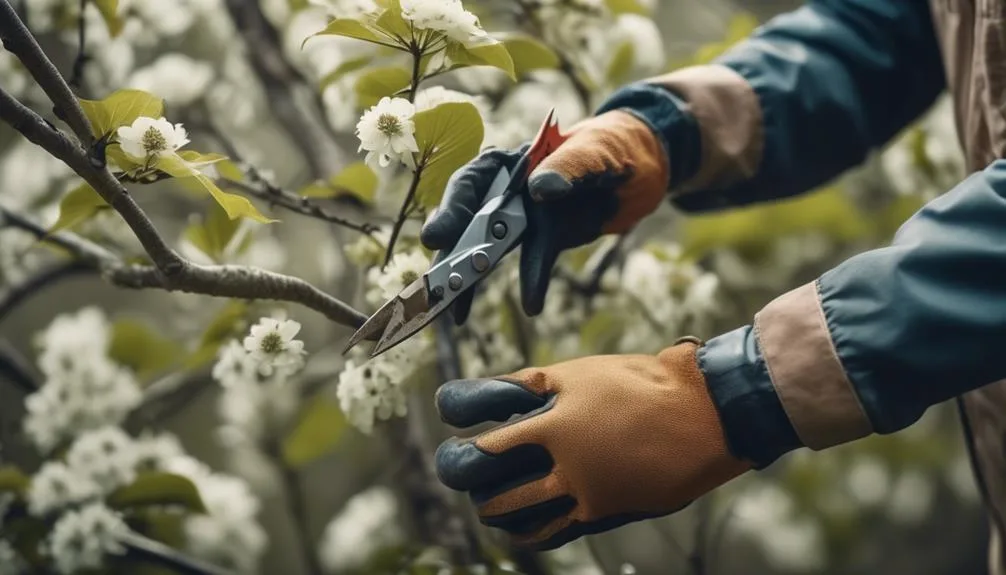Are pests bugging your dogwood trees?
As a dogwood tree owner, you want to keep them healthy and pest-free.
In this discussion, we'll look at practical ways to identify, control, and prevent pests from harming your beloved trees.
Whether you prefer natural or chemical solutions, you'll find strategies to protect your trees from infestations.
Identifying Common Pests on Dogwood Trees
When inspecting your dogwood trees for pests, keep an eye out for common invaders such as aphids, dogwood borers, and scale insects. Identifying these pests is crucial for maintaining your tree's health.
Aphids are small, soft-bodied insects that can be green, black, or brown. They tend to cluster on the undersides of leaves and excrete a sticky substance called honeydew, which can lead to sooty mold growth.
Dogwood borers are destructive pests that leave entry holes and sawdust-like frass on the tree's trunk.
Scale insects, on the other hand, are small, immobile pests that can be mistaken for part of the tree. They often appear as bumps on the bark or leaves and can cause yellowing or stunted growth.
Identifying these pests early is essential for effective pest control and tree health.
Natural and Organic Pest Control Methods
To effectively address the pests previously identified, implementing natural and organic pest control methods is essential for maintaining the health of your dogwood trees.
Companion planting is an effective method to naturally control pests. For instance, planting garlic or alliums near your dogwood trees can help repel pests like aphids and spider mites. Additionally, marigolds can deter nematodes and other harmful soil-borne pests.
DIY pest repellents are another great option. You can create a simple homemade insecticidal soap by mixing mild dish soap with water and spraying it on the affected areas of the tree. Similarly, a mixture of neem oil and water can be used to control various pests while being gentle on the tree and the environment.
These natural and organic methods can help protect your dogwood trees without the use of harmful chemicals.
Chemical Pest Control Options for Dogwood Trees
Consider chemical pest control options for dogwood trees when natural and organic methods haven't effectively addressed the pest infestation. When opting for chemical pest control, safety precautions are crucial. Always wear protective clothing, gloves, and a mask when applying chemical pesticides to dogwood trees. Follow the manufacturer's instructions carefully and keep pets and children away from treated areas.
Additionally, consider the environmental impact of the chemical pesticides you choose. Look for products that are targeted specifically to the pests affecting your dogwood trees to minimize the impact on beneficial insects and wildlife.
Always use chemical pest control options as a last resort and consider consulting with a professional arborist or extension office for guidance on the most appropriate and least impactful chemical treatments for your dogwood trees.
Preventing Future Pest Infestations on Dogwood Trees
To prevent future pest infestations on your dogwood trees, implementing cultural and preventive practices is essential. Here are four effective methods to keep pests at bay:
- Soil amendments: Maintain well-draining soil with good organic matter to promote the overall health of your dogwood trees. Healthy trees are more resistant to pests and diseases.
- Companion planting: Consider planting pest-repelling plants such as marigolds or garlic near your dogwood trees to deter pests naturally.
- Regular pruning: Keep your dogwood trees pruned to remove any dead or diseased branches, which can attract pests and lead to infestations.
- Proper watering and fertilization: Avoid overwatering, as soggy soil can stress the trees and make them more susceptible to pests. Additionally, ensure proper fertilization to maintain tree vigor and resistance to pests.
Seeking Professional Help for Severe Pest Issues
If your dogwood trees are facing severe pest issues despite implementing cultural and preventive practices, seeking professional help can effectively address the problem and protect the health of your trees.
Professional treatment for severe pest infestations on dogwood trees often involves the expertise of arborists or pest management professionals. These professionals can accurately identify the specific pests affecting your trees and recommend targeted treatment options.
They may utilize specialized insecticides, organic pest control methods, or beneficial predatory insects to manage the pest population. Additionally, they can provide ongoing monitoring and maintenance to ensure the long-term health and vitality of your dogwood trees.
When faced with severe pest issues that threaten the well-being of your trees, consulting with a professional can be crucial in effectively managing the problem and preserving the beauty of your landscape.
Conclusion
Remember, consistent monitoring and maintenance is key to keeping your dogwood trees healthy and free from pests.
Whether you opt for natural, organic, or chemical methods, taking proactive steps now can prevent future infestations.
If pest issues become severe, seek professional assistance to safeguard the well-being of your trees.
Your dedication to protecting your dogwood trees will ensure their long-term health and vitality.

My interest in trees started when I first saw the giant sequoias in Yosemite.
I was a teenager then, and I remember thinking, “I need to learn more about this.”
That moment stuck with me.
A few years later, I went on to study forestry at Michigan Tech.
Since graduating, I’ve worked in a mix of hands-on tree care and community education.
I’ve spent over ten years helping people understand how to plant, maintain, and protect the trees in their neighborhoods.
I don’t see trees as just part of the landscape.
They are living things that make a real difference in our daily lives.
